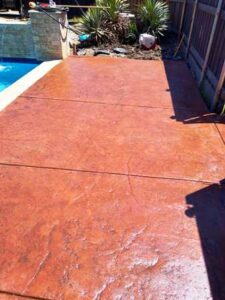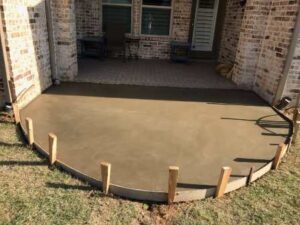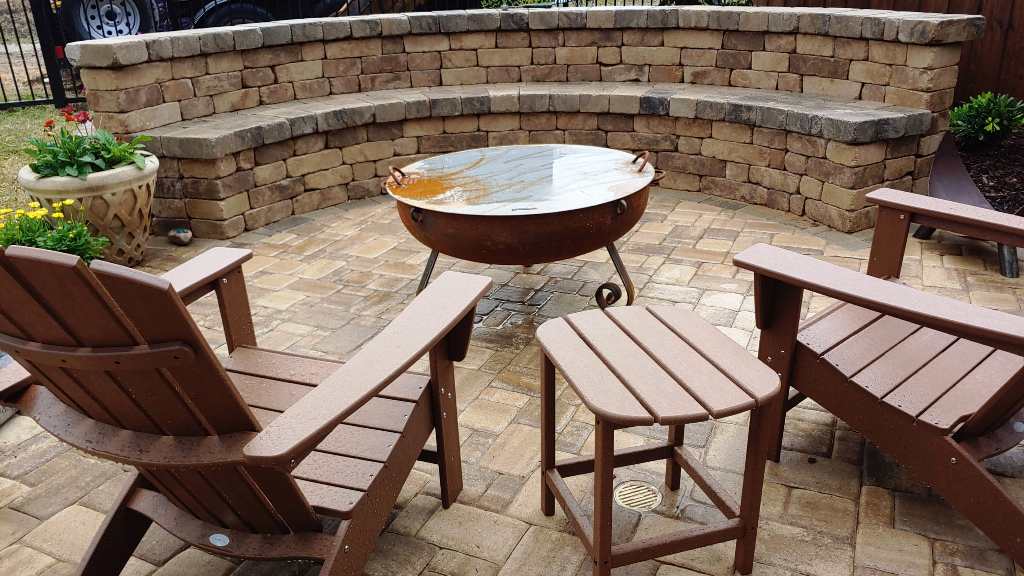
Concrete Staining
Staining concrete is the process of permanently applying a color to concrete. Concrete stain is available in most colors and can be blended to achieve a limitless number of styles.
Is it better to stain or paint concrete?
Staining concrete is the best way to provide a long-lasting color to a poured concrete slab. Painting is less expensive and easy to re-do, but it will not last as long as stain.
Can you stain old concrete?
Yes. You can stain old concrete, but it will need to be acid-washed to remove any oil, dirt, wax, etc. from the surface.
Is it hard to stain concrete?
The steps to stain concrete are simple and straightforward. However, staining is permanent, so it should be done carefully and thoughtfully and by a qualified landscaping company.

Install Pavers
Paver installation is a great alternative to a concrete slab when you are creating a pathway or patio space. Pavers are durable and available in a wide variety of shapes and styles.
Is it cheaper to lay concrete or pavers?
It is less expensive to lay concrete than it is to install pavers. Though, pavers are one of the best paving materials for our North Texas area.
Can you lay pavers on dirt?
You can certainly install pavers directly on top of soil for small stepping stones or like that in a gravel stone walkway.
For larger areas such as a patio, install your pavers on top of a more solid surface such as compacted decomposed granite or concrete.
Are pavers worth the money?
A well-constructed paver patio is one of a kind. Hardscaping work can add between 5%-13% to your overall home value.

Lay Outdoor Porcelain Tile
Laying outdoor porcelain tile is another great option to consider when creating a patio surface. Porcelain is durable and available in an endless number of styles and looks.
Is porcelain tile good for outdoors?
Yes, porcelain tile is extremely durable and can absolutely be used for outdoor applications. Because porcelain tile is thin, you will want to install it directly on top of a concrete surface.
Is ceramic or porcelain tile better for outdoors?
Porcelain tile is generally the better choice for outdoor landscape installations. Porcelain tile is stronger, denser and offers better weather resistance.
Does porcelain tile need to be sealed?
Porcelain tile does not need to be sealed. Some homeowners prefer to seal it to provide easier cleaning, but it’s not necessary to preserve the tile.

Concrete Paint
For a quick style upgrade, consider painting your existing concrete slab. Concrete paint is an easy DIY task for any homeowner and can last for several years.
What is the best paint to use on concrete?
The best paint to use on concrete is masonry paint. Masonry paint is the most appropriate because it contains particular binding materials which expand and contract like concrete. These binders in the paint will prevent cracking.
Do I need to prime concrete before painting?
Concrete should definitely be primed before painting. Start by cleaning the concrete surface, then prime and paint.
How long does concrete paint last outside?
Depending on the quality of concrete paint used, it can last between 7-10 years before needing touch up.
A new stone patio can be costly, so painting concrete is a budget friendly option in the short term.

Concrete Resurfacing
To bring new life to your old concrete slab, you can simply resurface it. Concrete resurfacing is basically adding a fresh layer of concrete on top of your old one.
Can you concrete over old concrete?
Yes, you can add concrete over old concrete. You will need to ensure that the existing concrete surface is completely clean and free of any major cracks in order for the resurfacing to hold.
Many homeowners elect to refinish old concrete sidewalks, in their front yard landscaping plans, to coordinate with stone installed around a new flower bed.
Does concrete resurfacing last?
When installed correctly, resurfaced concrete can last between 7-12 years. The durability of resurfaced concrete will depend largely on the integrity of the base concrete in addition to how well the resurfacing has bonded.
How thick should concrete resurfacing be?
For concrete resurfacing to fully bond with original concrete, a 1-2 inch resurfacing thickness is recommended.
